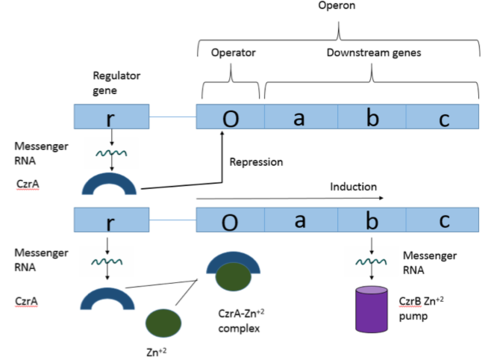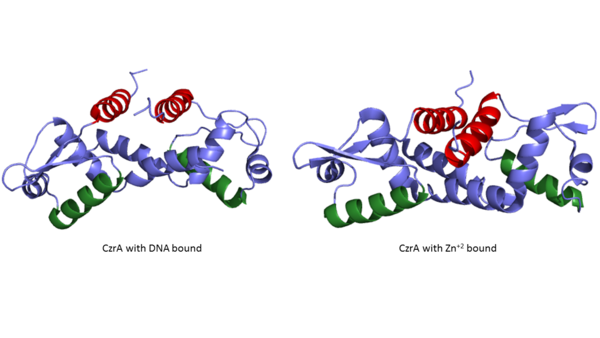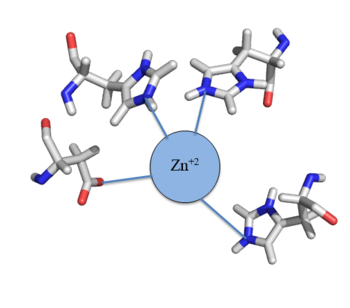Sandbox Reserved 1053
From Proteopedia
(Difference between revisions)
| Line 12: | Line 12: | ||
Czr A is a transcriptional repressor protein responsible for the regulation of the Czr operon<ref name="critical">Arunkumar A., Campanello G., Giedroc D. (2009). Solution Structure of a | Czr A is a transcriptional repressor protein responsible for the regulation of the Czr operon<ref name="critical">Arunkumar A., Campanello G., Giedroc D. (2009). Solution Structure of a | ||
paradigm ArsR family zinc sensor in the DNA-bound state. PNAS 106:43 | paradigm ArsR family zinc sensor in the DNA-bound state. PNAS 106:43 | ||
| - | 18177-18182.</ref>. The Czr operon contains genes for the proteins Czr A and [http://proteopedia.org/wiki/index.php/3byr Czr B]. Czr B is a Zinc transport protein which moves Zn<sup>2+</sup> out of a cell while Czr A regulates this process by controlling expression level of Czr B. When relatively low amounts of zinc are present in the cell Czr A will bind to DNA, preventing the progression of RNA polymerase and thus inhibiting expression of Czr B. Decreased expression of Czr B results in the ability of the cell to retain Zn<sup>2+</sup> more readily. Because Czr A and Czr B are transcribed as part of the same operon, an inhibitor of Czr A must be readily available to allow full transcription of Czr B when necessary. Czr A is noncompetitively inhibited by the binding of two Zn<sup>2+</sup> ions, which is ideal in that this allows for expression of Czr B, a Zn<sup>2+</sup> transporter to be dependent on the relative amount of Zn<sup>2+</sup> in the cell. Czr A displays two different conformations; the first typically binds DNA and has relatively low affinity for Zn<sup>2+</sup>. In this conformation the <scene name='69/694220/A5_helices__dna_binding/1'>a5 helices are aligned</scene>. Binding of zinc drives a conformational change in which the <scene name='69/694220/A5_helices_dna_binding/1'>a5 helices become unaligned</scene>, lowering the affinity for DNA. | + | 18177-18182.</ref>. The Czr operon contains genes for the proteins Czr A and [http://proteopedia.org/wiki/index.php/3byr Czr B]. Czr B is a Zinc transport protein which moves Zn<sup>2+</sup> out of a cell while Czr A regulates this process by controlling expression level of Czr B. When relatively low amounts of zinc are present in the cell Czr A will bind to DNA, preventing the progression of RNA polymerase and thus inhibiting expression of Czr B. Decreased expression of Czr B results in the ability of the cell to retain Zn<sup>2+</sup> more readily. Because Czr A and Czr B are transcribed as part of the same operon, an inhibitor of Czr A must be readily available to allow full transcription of Czr B when necessary. Czr A is noncompetitively inhibited by the binding of two Zn<sup>2+</sup> ions, which is ideal in that this allows for expression of Czr B, a Zn<sup>2+</sup> transporter to be dependent on the relative amount of Zn<sup>2+</sup> in the cell. Czr A displays two different conformations; the first typically binds DNA and has relatively low affinity for Zn<sup>2+</sup> (PDB code: 2kjb). In this conformation the <scene name='69/694220/A5_helices__dna_binding/1'>a5 helices are aligned</scene>. Binding of zinc drives a conformational change (PDB code: 2kjc) in which the <scene name='69/694220/A5_helices_dna_binding/1'>a5 helices become unaligned</scene>, lowering the affinity for DNA. |
===DNA Binding === | ===DNA Binding === | ||
Czr A performs it's primary function when bound to DNA<ref name="critical"/>. Each monomeric subunit of the protein binds DNA individually, coming together once attached to the DNA. While bound, Czr A prevents the transcription of the DNA in the Czr operon, acting as a repressor protein and effectively turning off the operon. As was briefly mentioned above, the Czr operon contains the gene responsible for producing Czr B, a metal transport protein which regulates the concentration of zinc in the cell. So, by extension, Czr A is responsible for retaining Zn<sup>2+</sup> inside the cell by inhibiting the production of the protein responsible for transporting zinc out of the cell. | Czr A performs it's primary function when bound to DNA<ref name="critical"/>. Each monomeric subunit of the protein binds DNA individually, coming together once attached to the DNA. While bound, Czr A prevents the transcription of the DNA in the Czr operon, acting as a repressor protein and effectively turning off the operon. As was briefly mentioned above, the Czr operon contains the gene responsible for producing Czr B, a metal transport protein which regulates the concentration of zinc in the cell. So, by extension, Czr A is responsible for retaining Zn<sup>2+</sup> inside the cell by inhibiting the production of the protein responsible for transporting zinc out of the cell. | ||
Revision as of 13:13, 18 April 2017
CzrA: A Zinc Dependent Transcriptional Regulator
| |||||||||||
References
- ↑ 1.0 1.1 1.2 1.3 1.4 Arunkumar A., Campanello G., Giedroc D. (2009). Solution Structure of a paradigm ArsR family zinc sensor in the DNA-bound state. PNAS 106:43 18177-18182.
- ↑ Chakravorty DK, Wang B, Lee CW, Giedroc DP, Merz KM Jr. Simulations of allosteric motions in the zinc sensor CzrA. J Am Chem Soc. 2012 Feb 22;134(7):3367-76. doi: 10.1021/ja208047b. Epub 2011 Nov , 14. PMID:22007899 doi:http://dx.doi.org/10.1021/ja208047b
- ↑ MacPherson S, Larochelle M, Turcotte B. A fungal family of transcriptional regulators: the zinc cluster proteins. Microbiol Mol Biol Rev. 2006 Sep;70(3):583-604. PMID:16959962 doi:http://dx.doi.org/10.1128/MMBR.00015-06
- ↑ Miller J, McLachlan AD, Klug A. Repetitive zinc-binding domains in the protein transcription factor IIIA from Xenopus oocytes. EMBO J. 1985 Jun 4;4(6):1609-1614.
- ↑ Grossoehme NE, Giedroc DP. Energetics of allosteric negative coupling in the zinc sensor S. aureus CzrA. J Am Chem Soc. 2009 Dec 16;131(49):17860-70. doi: 10.1021/ja906131b. PMID:19995076 doi:http://dx.doi.org/10.1021/ja906131b



